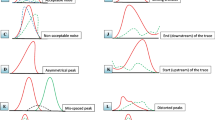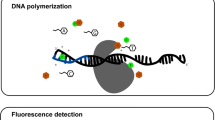Abstract
We have evaluated a multiplex STR system for routine forensic use, which co-amplifies six short tandem repeat (STR) loci; HUMTH01, D21S11, D18S51, D8S1179, HUMVWF31/A and HUMFIBRA (FGA), in conjunction with the X-Y homologous gene Amelogenin. Analysis of PCR products employs denaturing polyacrylamide gels coupled with fluorescentlabelled primers and detection is undertaken on ABD 373A automated sequencers. The technique was shown to be robust and reproducible when samples were analysed under conditions consistent with those encountered in a forensic environment.
The system was demonstrated to be human specific and is suitable for use with both aged and degraded material. Somatic stability was proven with a wide range of tissue types and we were able to detect mixtures at ratios between 1:10 and 10: 1. During this study no incidence of sample mis-typing due to allelic or locus drop-out was observed. Furthermore, although additional artefact bands were occasionally encountered these did not interfere with the interpretation of results. The performance of the system with poor quality samples demonstrated its suitability as a powerful tool in forensic investigation.
Similar content being viewed by others
References
Hagelberg E, Gray IC, Jeffreys AJ (1991) Identification of the skeletal remains of a murder victim by DNA analysis. Nature 352:427–429
Jeffreys AJ, Allen MJ, Hagelberg E, Sonnberg A (1992) Identification of the skeletal remains of Josef Mengele by DNA analysis. Forensic Sci Int 56:65–76
Wiegand P, Bajanowski T, Brinkmann B (1993) DNA typing of debris from fingernails. Int J Legal Med 106:81–83
Gill P, Ivanov P, Kimpton CP, Piercy R, Benson NJ, Tully G, Evett I, Hagelberg E, Sullivan KM (1993) Identification of the Romanov family by DNA analysis. Nature Genet 6:130–135
Monaghan B, Newhall P (1996) STR results for both epithelial and spermatozoal fractions obtained from 13-year old microscope slides of vaginal swab material. Can Soc Forensic Sci J 29:13–19
Whitaker JP, Clayton TM, Urquhart A, Millican E, Downs TJ, Kimpton CP, Gill P (1995) Short tandem repeat typing of bodies from a mass disaster: high success rate and characteristic amplification patterns in highly degraded samples. Biotechniques 18:670–677
Weber J, May P (1989) Abundant class of human DNA polymorphisms which can be typed using the polymerase chain reaction. Am J Hum Genet 44:388–396
Beckman JS, Weber JL (1992) Survey of human and rat microsatellites. Genomics 12:627–631
Wiegand P, Budowle B, Rand S, Brinkmann B (1993) Forensic validation of the STR systems SE33 and TC11. Int J Legal Med 105:315–320
Kimpton CP, Gill P, Walton A, Urquhart A, Millican ES, Adams M (1993) Automated DNA profiling employing multiplex amplification of short tandem repeat loci. PCR Methods Appl 3:13–22
Oldroyd NJ, Urquhart A, Kimpton CP, Downs TJ, Millican ES, Watson SK, Gill PD (1995) A highly discriminating octoplex short tandem repeat polymerase chain reaction system suitable for human individual identification. Electrophoresis 16:334–337
Urquhart A, Kimpton CP, Downs TJ, Gill P (1994) Variation in short tandem repeat sequences — a survey of 12 microsatellite loci for use as forensic identification markers. Int J Legal Med 107:13–20
Gill P, Kimpton CP, Urquhart A, Oldroyd N, Millican E, Watson S, Downs TJ (1995) Automated short tandem repeat (STR) analysis in forensic casework — a strategy for the future. Electrophoresis 16:1543–1552
Kimpton CP, Oldroyd N, Watson S, Frazier R, Johnson P, Millican E, Urquhart A, Sparkes R, Gill P (1996) Validation of a highly discriminating octoplex STR amplification system for individual identification. Electrophoresis, in press
Ziegle JS, Su Y, Corcoran KP, Nie L, Maryrand PE, Hoff LB, McBride LJ, Kronick MN, Diehl SR (1992) Application of automated DNA sizing technology for genotyping microsatellite loci. Genomics 14:1026–1031
Fregeau CJ, Fourney RM (1993) DNA typing with fluorescently tagged short tandem repeats: a sensitive and accurate approach to human identification. Biotechniques 15:100–109
Robertson JM, Sgueglia JB, Badger CA, Juston AC, Ballantyne J (1995) Forensic applications of a rapid, sensitive and precise multiplex analysis of the four short tandem repeat loci HUMVWF31/A, HUMTH01, HUMF13A1 and HUMFES/FPS. Electrophoresis 16:1568–1579
Mayrand PE, Corcoran K, Ziegle J, Robertson J, Hoff L, Kronick M (1992) The use of fluoresecence detection and internal lane standards to size PCR products automatically. Appl Theor Electrophor 3:1–11
DNA recommendations — 1992 report concerning recommendations of the DNA Commission of the International Society of Forensic Haemogenetics relating to the use of PCR-based polymorphisms. Int J Legal Med 104:63–64
Sparkes RL, Kimpton CP, Gilbard S, Came P, Andersen J, Thomas D, Oldroyd N, Urquhart A, Gill P (1996) The validation of a 7-locus multiplex STR test for use in forensic case-work (II) Int J Legal Med, in press
Gill P, Urquhart A, Millican E, Oldroyd N, Watson S, Sparkes R, Kimpton C (1996) A new method of STR interpretation using inferential logic — development of a criminal intelligence database. Int J Legal Med 109:14–22
Walsh PS, Metzgar DA, Higuchi R (1991) Chelex™ 100 as a medium for the simple extraction of DNA for PCR based typing from forensic material. Biotechniques 1:91–98
Walsh PS, Varario J, Reynolds R (1992) A rapid chemiluminescent method for quantitation of human DNA. Nucleic Acids Res 20:5061–5065
Waye JS, Willard HF (1986) Structure, organisation, and sequence of alpha satellite DNA from human chromosome 17: evidence for evolution by unequal crossing-over and an ancestral pentamer repeat shared with the human X chromosome. Mol Cell Biol 6:3156–3165
Elder JK, Southern E (1987) Computer-aided analysis of one dimensional restriction length fragment gels. In: Bishop MJ, Rawling CK (eds) Nucleic acid and protein sequence analysis. IRL press, Oxford, pp 165–172
Urquhart A, Chin CT, Clayton T, Downes T, Frazier R, Jones S, Kimpton C, Lareu MV, Millican E, Oldroyd N, Thompson C, Watson S, Whitaker J, Gill P (1995) Multiplex STR systems with fluorescent detection as human identification markers. Proceedings of the 5th International Symposium on Human Identification 1994. Promega Corp Madison, Wisc. pp 73–83
Clayton T, Whitaker J, Maguire C (1995) Identification of bodies from the scene of a mass disaster using DNA amplification of short tandem repeat (STR) loci. Forensic Sci Int 76:7–15
Clayton TM, Fisher D, Holland M, Lee D, Weedn VW, Whitaker J, DiZino J, Kimpton C, Gill P (1995) Further validation of a quadruplex STR DNA typing system: a collaborative effort to identify victims of a mass disaster. Forensic Sci Int 76:17–25
Lygo JE, Johnson PE, Holdaway DJ, Woodroffe S, Whitaker JP, Clayton TM, Kimpton CP, Gill P (1994) The validation of short tandem repeat (STR) loci for use in forensic casework. Int J Legal Med 106:302–311
Author information
Authors and Affiliations
Rights and permissions
About this article
Cite this article
Sparkes, R., Kimpton, C., Watson, S. et al. The validation of a 7-locus multiplex STIR test for use in forensic casework. Int J Leg Med 109, 186–194 (1996). https://doi.org/10.1007/BF01225517
Received:
Revised:
Issue Date:
DOI: https://doi.org/10.1007/BF01225517




